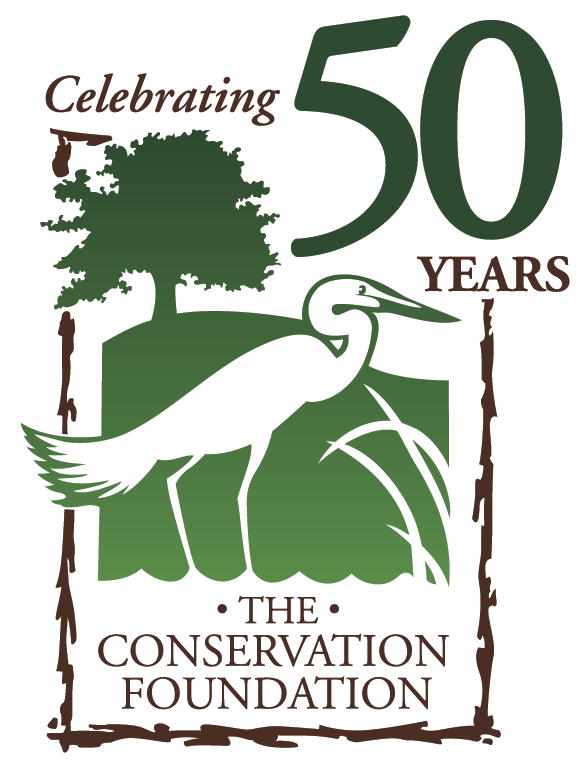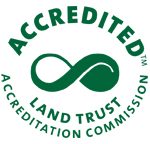McDonald Farm
Headquarters of The Conservation Foundation and Main Offices
 Lenore McDonald’s donation of the 60-acre McDonald Farm in 1992 was a transformative gift for The Conservation Foundation, and also for Lenore herself. She found great peace in knowing her beloved farm would be protected from the developers who knocked daily at her door, and would be used to carry on the causes of agriculture, conservation and education that were dear to her heart.
Lenore McDonald’s donation of the 60-acre McDonald Farm in 1992 was a transformative gift for The Conservation Foundation, and also for Lenore herself. She found great peace in knowing her beloved farm would be protected from the developers who knocked daily at her door, and would be used to carry on the causes of agriculture, conservation and education that were dear to her heart.
Lenore’s story is incredibly remarkable and inspiring, but the history of McDonald Farm long precedes the wiry, spunky woman who left such a legacy.
For 20 years, the Green Earth Institute leased McDonald Farm’s tillable acreage for their Community Supported Agriculture program. That partnership culminated in the 2018 merger of the two organizations, in which the Green Earth Institute became a major program of The Conservation Foundation.
The McDonald Farm is also home to another nonprofit, the Resiliency Institute.
Before it was McDonald Farm
Settlement of land in the vicinity of the McDonald Farm began in the 1830s. However, the land was owned by the Federal government and could not be legally acquired by individuals until sale had been authorized by Congress and the property had been surveyed. Action by Congress and survey work was not completed until the early 1840s. At that time, two individuals who had previously “claimed” the property deeded it to Jonathon Royce.
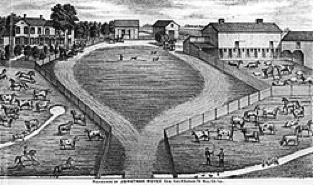
The farm did well in the following decades. A drawing of the farm in the 1873 “Will County Atlas” presented a picture of agricultural prosperity. There were substantial and well maintained barns and other buildings. The fields were full of cattle, sheep and horses. There was an orchard. And there was a very large house–we have been told that it contained 23 rooms when it burned down in the 1920s.
The Royce Family continued to own the farm until about 1926. At that time the property was sold to John Miller, an immigrant from Serbia. The Miller family managed to make loan payments and were able to hold on to the farm during the Depression. Plenty of hands were available to help with the farming chores–there were 14 Miller children. Over the years a few of them have visited us and shared memories of growing up here. The Miller’s sold the farm in the early 1940s to an individual who purchased it as an investment. Sterling and Lenore McDonald purchased the farm in 1949.
The McDonald’s set out in 1949 to rejuvenate a property that had fallen on hard times. The huge Royce farmhouse that had burned in the 1920s had been replaced by a much more modest house. The major part of that house had been removed from the property. The McDonald’s built a new ranch-style house on the site where the previous houses had stood. This house must have been the talk of the neighborhood–it had a dishwasher! You’ll see the same dishwasher in our office kitchen today, and it still works. The McDonald’s also rehabilitated the barns and other buildings.
Lenore McDonald continued to live on the farm after her husband Sterling’s death in 1966. By the late 1970s the neighborhood was changing dramatically. Farms were disappearing and being replacing with subdivisions. In less than ten years, what had been farms as far as the eye could see were now houses. The McDonald Farm was the only holdout.

In order to ensure that her wish would be honored, Lenore gave her farm to The Conservation Foundation in 1992. Her donation specified that the property must be kept in conservation, education, and agricultural uses. Lenore retained a life estate, giving her full use of the property until her death or until she chose to relinquish the life estate. She did the latter in late 1997, passing full control of McDonald Farm to The Conservation Foundation.
The Conservation Foundation’s offices moved to McDonald Farm in the spring of 1998. Since then we have been working hard to maintain and improve the property and use it to further the causes of conservation, education and agriculture in accordance with Lenore’s wishes.
Ever stubborn, Lenore continued operating the farm as she had always done. But her task increasingly became one of holding out against the encroachment of suburbia. The City of Naperville dried up ponds on the property, cut trees to widen Knoch Knolls Road, and built sewer and stormwater lines across the property. It became difficult to move farm equipment on busy suburban streets. Streets in the adjoining subdivisions were paved right up to the property line. Everything seemed to be pointing to a not very distant day when the McDonald Farm would be just another subdivision.
Sometimes greeting them with shotgun in hand, Lenore turned away the developers who stopped by to offer more and more money for the property. Even though the temptation must have been great to take the money and move beyond the reach of suburbia, she had decided that no one was going to build houses on her farm.
Lenore's Story
On a hot July day, a man in a dapper suit gets out of his shiny black car, brushes gravel dust from the lane off of his starched jacket, and confidently approaches the farmhouse door. Before he can even knock he is greeted by the steely barrel of the shotgun wielded by a short, wiry spitfire of a woman, her gray hair pulled tightly into a bun. Sound like a scene from “The Beverly Hillbillies”? It’s actually a scene that played itself out almost daily, like a tired rerun, in the late eighties and nineties at a farm right here in Naperville.
The spitfire was Lenore (Clow) McDonald, and the shotgun was her polite way of declining the offer of Mr. Dapper Suit and every other developer who ever knocked on her door. Lenore deeply loved her land, and realized that if she was going to save it she was going to need more permanent protection than a shotgun. So in 1992 she donated the 60-acre farm to The Conservation Foundation, a local nonprofit she had come to trust for our work saving land and rivers in the area. Lenore knew the Foundation was in the business of “forever,” and forever open is the vision she had for her beloved land.
As home to The Conservation Foundation and the Green Earth Institute, a separate nonprofit who leases the farmland to grow organic vegetables, the McDonald Farm is a showcase of Naperville’s rich agricultural, historical and natural heritage. There’s a lot of good going on up our quarter mile long (still gravel) lane. We invite you to come see what Lenore McDonald fought so hard to protect, and be part of that legacy by becoming a supporter today. Click here to become a member , or give us a call at 630-428-4500.
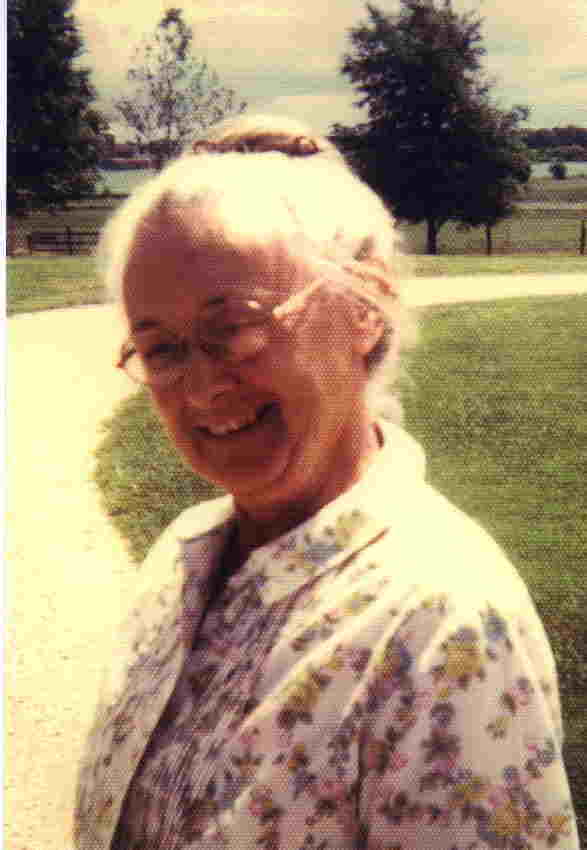
Good Nature Grows at McDonald Farm
We have conservation and education pretty well covered under our mission at McDonald Farm. We kept the farm fields in traditional corn and beans agriculture until striking up a fortuitous partnership with the Green Earth Institute in 2002. Also a private non-profit, the Green Earth Institute is dedicated to promoting nutritional health and ecological sustainability. They were a natural partner for The Conservation Foundation, and until 2018 leased McDonald Farm’s 49 tillable acres to grow healthy, organic vegetables for their Community Supported Agriculture (CSA). In 2018, the Green Earth Institute merged with us to become the Green Earth Harvest, a major program of The Conservation Foundation.
Lenore’s descendants have told us that she loved to mow, even landing herself and her mower in the pond a time or two. Meaning her no disrespect, we’ve turned much of the Farm’s grassy areas into native gardens, restored wetlands that had been channeled into an underground pipe, installed solar panels, a wind turbine, permeable pavement and two rainwater harvesting systems. We’re working to make McDonald Farm a showcase of conservation in action that will stir others to act as well. Click here to learn more about sustainability at McDonald Farm.
Another partner organization, The Resiliency Institute, also calls the McDonald Farm home. The Resiliency Institute uses permaculture design to create resilient suburban communities and holds many of their educational activities right here on the farm. For more information about The Resiliency Institute, visit http://www.theresiliencyinstitute.net/
It is beyond inspiring to think of all of the good that has come from one woman’s love of and dream for her land. For the people and wildlife of Naperville, McDonald Farm is an oasis of nature in a sea of subdivisions. There’s a lot of good going on up our quarter mile long lane. Stop in sometime for a self-guided tour and a chat with whatever staff members happen to be around.
Water Conservation & Renewable Energy
The 60-acre McDonald Farm in Naperville is the place The Conservation Foundation calls home. The Farm’s water conservation and renewable energy project clearly demonstrates the enviromentally responsible ideals we stand for to all of our visitors. We are working hard to make McDonald Farm a showcase of conservation in action that will stir others to act as well.
Our 1850s barn and granary were in dire need of new roofs. We viewed it as an opportunity to solve a problem, do the right thing for the environment and provide a helpful example of what others can do as well. Instead of simply installing traditional asphalt roofing material, we completed a renewable energy and water conservation demonstration project. The project shows our visitors real options that people can use at their homes and places of business to be good stewards of the environment.
Project Details
In an effort to make McDonald Farm a concrete example of conservation principles put to use, we have installed two rainwater harvesting systems-including one of the largest in the Chicagoland area, set up numerous rain barrels, redesigned and planted several native gardens, and restored 8 acres of wetland. We have also replaced the barn and granary roofs with high recycled content metal roofing and installed solar panels on the main barn roof. A small 60-foot wind turbine has also been installed and is spinning away. This project has four interconnected components: Rainwater Harvesting, Renewable Solar and Wind Energy, Roofing Material and Education. Click on each component title for details.
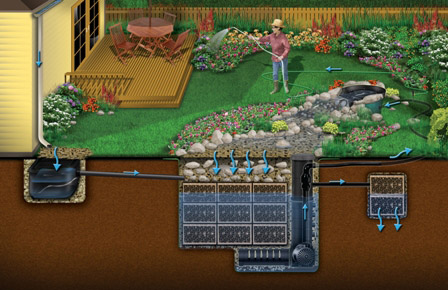
Objective: Demonstrate a new stormwater best management practice by directing 100% of all rainwater from the barn roof into the 25,000 gallon rainwater harvesting system to be used to irrigate organic vegetables.
Aquascape Designs of St. Charles installed a 25,000 gallon rainwater harvesting system between the main barn and the granary. This sytem is one of the largest in the Chicagoland area. After the installation of new recycled metal roofs on our barns, 100% of their rainwater runoff was directed into this rainwater harvesting system to be used by the Green Earth Institute, an organic farming operation that leases McDonald Farm’s fields, to irrigate their organic vegetables.
Objective: Demonstrate a new stormwater best management practice by directing 100% of all rainwater from the barn roof into the 25,000 gallon rainwater harvesting system to be used to irrigate organic vegetables.
Aquascape Designs of St. Charles installed a 25,000 gallon rainwater harvesting system between the main barn and the granary. This sytem is one of the largest in the Chicagoland area. After the installation of new recycled metal roofs on our barns, 100% of their rainwater runoff was directed into this rainwater harvesting system to be used by the Green Earth Institute, an organic farming operation that leases McDonald Farm’s fields, to irrigate their organic vegetables.
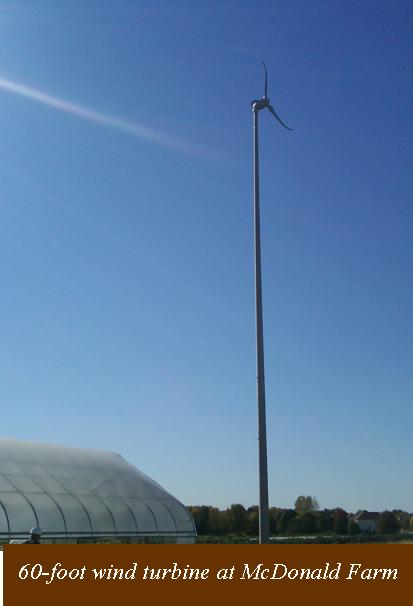 Objective: Demonstrate a simple solar panel system and small wind turbine options for residential, commercial and agricultural purposes, and utilize the energy generated by the solar and small wind systems to power the rainwater harvesting and irrigation pumps, with any extra power generated being sent back to the grid.
Objective: Demonstrate a simple solar panel system and small wind turbine options for residential, commercial and agricultural purposes, and utilize the energy generated by the solar and small wind systems to power the rainwater harvesting and irrigation pumps, with any extra power generated being sent back to the grid.
Solar photovoltaic panels (2.4Kw) have been installed (in July 2010) on one side of the main barn roof that faces south by Solar Services out of Niles. This system demonstrates how easy it is to generate electricity in any situation with direct sunlight.
We have also installed (in October 2010) one 60-foot pole-mounted wind turbine (2.4 Kw SkyStream 3.7), provided by Monarch Renewable Energy of Elgin, in the adjacent farm field next to the barn. Electricity generated is metered, tracked and sent directly to the grid.
Objective: Demonstrate environmentally friendly roofing options by replacing the roof on the main barn, granary and chicken coop with recycled and environmentally friendly roofing materials.
Facing a severely degraded and leaking barn roof, we saw an opportunity to demonstrate to the public that there are environmentally friendly roofing options. Instead of replacing the roofs on the main barn, granary and attached chicken coop with traditional asphalt shingles, we chose a high recycled content metal roof called Central Guard Panel-Loc Plus manufactured by Central States Manufacturing.
Other “green” roofing options include recycled metal such as aluminum and products that use a combination of recycled plastics and rubber materials. One product even uses crushed limestone powder with plastic to replicate slate shingles.
We wanted to be able to point to the roof and tell someone, “There are one million beer cans in this roof,” such as in the case of our metal roof, green both in color and in its environmental impact.
Objective: Use this demonstration project as an effective public and school educational tool on environmental sustainability in general and on each component specifically, promote rainwater harvesting as a new stormwater best management practice to local units of government and the stormwater industry, and continue to showcase the McDonald Farm as a sustainable urban agricultural landscape that promotes innovation while preserving the cultural and historic nature of the site and the community.
Since this project is a demonstration and adds to the “menu” of other sustainable projects at McDonald Farm, education is the primary objective. We hold annual technical training and workshops at the Farm’s Clow Education Center, along with several workshops, seminars and tours of the site for the public. We have created and installed interactive interpretive signage and outdoor exhibits to explain these technologies to the public and how they can get involved in these and other sustainable practices. Thousands of people visit McDonald Farm each year for educational programs, tours, camps and produce pick-ups. It’s only through continued education that we can encourage the use of environmentally friendly practices. The public needs to know that these technologies are available to them.
After installation was completed, we hosted a Small Scale Renewable Energy and Water Conservation Open House and Workshop event to showcase the project and hear more about these technologies from experts in the field. Click on the titles below to see presentations from this informative day:
The ultimate outcome for this project is to encourage people to consider these, and the many other environmentally friendly practices demonstrated at the McDonald Farm, as realistic ideas they can implement at their homes or places of business. These are easy and affordable “green” living ideas that will, if more people do them, make a measurable difference in protecting and improving our local environment.
McDonald Farm is much more than home base for our regional conservation efforts. It is an educational tool we use to teach the community about our mission to preserve and restore open space and natural lands, protect rivers and watersheds, and promote sustainable development. On-the-ground examples of native landscaping, rainwater harvesting, permeable pavers, water and butterfly gardens, rain gardens and rain barrels are all in place to show the thousands of people who visit us each year how to live in concert with nature. The Conservation Foundation uses these examples to promote and educate the public on how they can conserve water, improve water quality and bring nature closer to them at their home or place of business. Special events, programs, classes, camps and the Green Earth Institute’s organic farming operation, which leases the farmland from The Conservation Foundation, bring families and schoolchildren to the farm each year.
How You Can Help
We encourage you to visit the farm and learn more about who we are and what we are doing. Come see your donation in action as we strive to be an example of how to build better, more sustainable energy options and work to conserve water, our most precious resource.
Project Support
We’d like to thank the following funders and partners in this unique project:
Aquascape Designs, Inc.
DuPage Community Foundation
DuPage County Stormwater
Green Earth Institute
Greenway Energy
Illinois Clean Energy Community Foundation
Monarch Renewable Energy
State of Illinois DECEO
Solar Systems
Testing Services Corporation
Wight & Company
Our Native American Land Acknowledgment Statement is a formal statement that recognizes and respects Indigenous Peoples as traditional stewards of this land and the enduring relationship that exists between Indigenous Peoples and their traditional territories.
Directions
The Conservation Foundation
10S404 Knoch Knolls Road
Naperville, Illinois 60565
